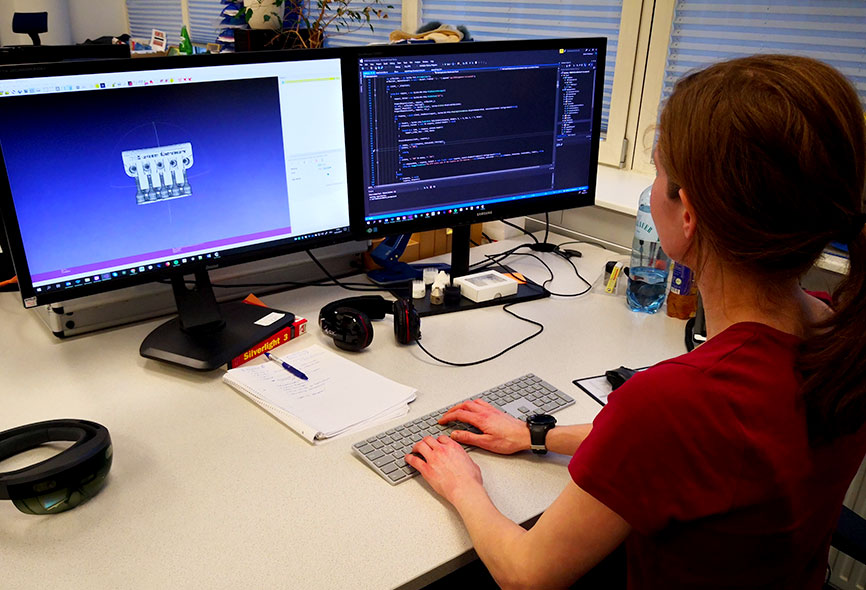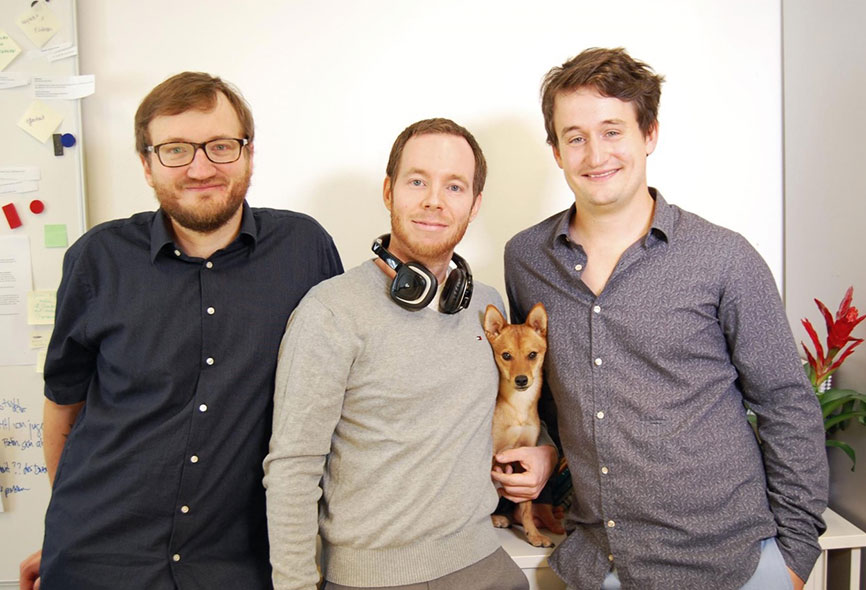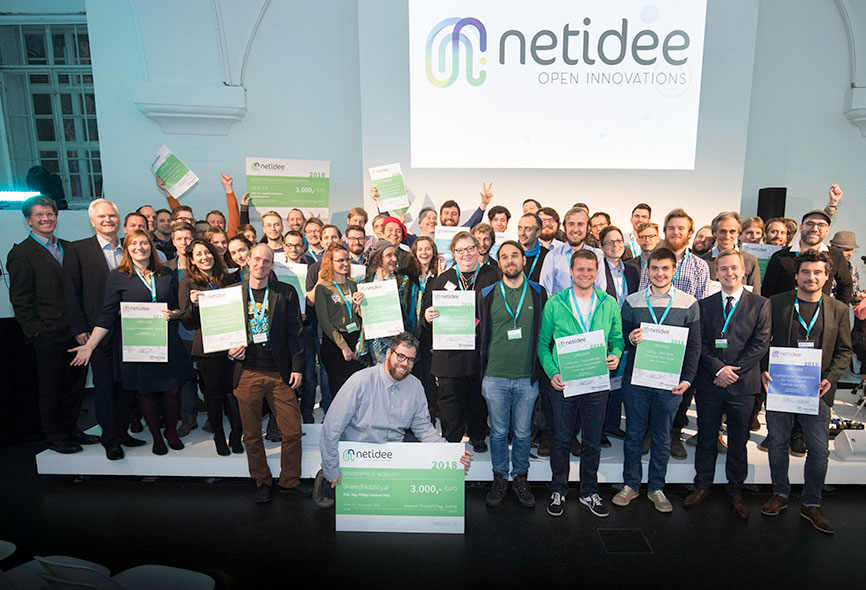Anyone who has worked on a project for some time knows this situation: Unexpected obstacles appear, the motivation is quickly on the verge of a collapse and the timetable has to be thrown overboard – perhaps even the project itself in the end. But that doesn’t have to happen at all. We asked three young teams of software developers what they are currently working on, why they started their project and when they find time to work on it: The CADMeshConverter by Sabine Pölzlbauer and Georg Wernitznig should make it possible to simplify CAD models apart from large software packages, the game editor AudiCom by Florian Güldenpfennig, Michael Urbanek and Michael Habiger wants to make it easier to create audio games, and “out of tune” by Samuel Daurer and Amilian Mayrhofer wants to offer music recommendations that are more transparent than conventional algorithms.
There are three projects that have three things in common: They are programmed in a team, are not yet fully developed and they are among the winners of the netidee. For the 13th time already, the Internet Private Foundation Austria has awarded the netidee, in which a sum of one million euros is made available each year for projects and scholarships to promote the Internet in Austria. In 2018, 25 project fundings and eight scholarships were awarded. Let’s ask around for once:

The CADMeshConverter is screwed here. Credit: Sabine Pölzlbauer
Why did you start developing your project?
Sabine Pölzlbauer (CADMeshConverter): The implementation of Augmented Reality (AR) projects confronts industrial partners again and again with the same hurdles when it comes to integrating CAD models. The preparation of 3-D models in the area of mobile end devices is very time-consuming and costly: it is done manually, which often means that additional functionalities fall through. The desire for an automated workflow became bigger and bigger, after all I already had to spend a lot of time with conversions and conversion tools and thus had less time for the exciting things of AR development.
What was it like with you? Why did you start the project?
Florian Güldenpfennig (AudiCom): Very short: Because there are no practical tools to design audio games and therefore the genre is not as widespread as we think it should be. Our team consists of three people and Michael Urbanek has been working on audio games and their design since his diploma thesis. What fascinates us about this genre is that the limitation to audio signals stimulates the imagination as well as being a challenge. For the development of conventional video games there are countless tools like Unity3D or Unreal Engine available – theoretically they are also suitable for the design of audio games, if you simply deactivate the graphical component. However, these game engines are difficult to purify and are also not barrier-free – this is important because many audio game designers have a visual impairment. This is where we come in: with our open source online editor, we want to offer a purified audio game development environment that is as barrier-free as possible and around which a community is to be created for exchange. We don’t want to position ourselves as a competitor to the already existing discussion platform audiogames.net (best regards to everyone there!), but we would like to create an environment with a focus on the design of audio games.
And what personal motivation did you have?
Samuel Daurer (Out of Tune): Some time ago my colleague Amilian Mayrhofer and I developed great enthusiasm for software development and information systems. That’s why we wanted to specialize in these areas with our diploma thesis. Music is also one of my greatest passions. With “Out of Tune” we want to give users more control over what they want to find – away from established algorithms for music recommendations. After all, every music fan sometimes wants to break out of his or her habits. In 2018, we also won the netidee special prize of the Prix Ars Electronica in the category “u19 – CREATE YOUR WORLD”. For us, the Ars Electronica Festival, all the impressions from there and the prize were of course a great motivation! The basic idea of the project is very close to my heart, and that was also the greatest motivation to continue. At the beginning, I set myself the goal of working on the project until I use the software myself every day. I think we are well on the way to achieving this goal.

During the Ars Electronica Festival 2018, Samuel Daurer was awarded with the netidee Special Prize by Ernst Langmantel of the Internet Private Foundation Austria. Credit: Tom Mesic
We have already reported on the music recommendation software “Out of Tune” on the Ars Electronica Blog. How about Audio Games – how would you describe the genre if someone had never heard of it before?
Michael Urbanek (AudiCom): Audio games are computer games whose main feedback is auditory and visual feedback is not relevant for progress in the game. The peculiarity of audio games, which makes the exploration of this genre so exciting, is the imagination. The game is understood differently by every player. A mysterious growl can generate different emotions – one player might imagine a medium-sized dog, another player might think of a bloodthirsty beast. Additional questions arise: What does the dog or monster look like? What color is it? Is it big, small? Does it have big eyes? Does it want to eat the grandmother? :-)
What else needs to be considered is the limited parallelism of auditory information. Visually a lot of information can be transported at the same time, icons, numbers, letters, characters, etc. We can also process these very quickly, since humans are visually strongly influenced creatures. Sounds that do not provide us with any relevant information are skillfully suppressed. The situation looks different from an auditory point of view. We can transport much less information at the same time and have to be aware of how much information we want to transport in the game. If we transport few to none, the player will not know his or her way around and will lose orientation. Every object in an audio game that doesn’t make a sound is virtually invisible! If we transport too much information at the same time, this leads to confusion or an unpleasant feeling in the game.
Short theme change to the construction of 3D objects: Why did you choose Open Source for your tool, which should make the conversion or simplification of CAD models possible?
Sabine Pölzlbauer (CADMeshConverter): A lot has happened in recent years with regard to conversion tools. Most software suites in this area are technologically flawless, but unfortunately very expensive and of course not open source, so this is simply out of the question for SMEs, students and interested parties. A free Open Source solution can solve the financial starting hurdle on the one hand, on the other hand the development can be pushed further by the community. Another advantage is clearly that individual requirements for the conversion workflow can be easily integrated, since the source code is published on Github at the end of the project.

An example of how CADMeshConverter works – before and after simplification.
All three projects received netidee funding in 2018 to promote further development. What concrete next steps are planned?
Sabine Pölzlbauer (CADMeshConverter): The next steps for us now are to extend the prototype and make it more stable. This includes for example the support of STEP files (STEP = Standard for the Exchange of Product Model Data) as input format as well as the validation of various parameters and files in the conversion process. Furthermore, the client application will be updated so that the automatic workflow can also be tested with regard to stability, performance and quality. These tests will provide insights during an evaluation round, which in turn will flow back into development.
Michael Habiger (AudiCom): Before the netidee-funding we had already done some preliminary work. For example, we talked to a number of audio gamers to find out what they particularly like about this genre. We also looked at the game design process and how games are actually developed. From that experience, we developed simple prototypes of audio game editors. We want to continue these enlightening conversations with gamers and designers, develop a sense for the community, and complete our picture. With these insights in mind, we will then set about developing a fast, interactive prototype as a web app.
Samuel Daurer (Out of Tune): We are currently developing a new prototype and have discarded our old one as we are now focusing on newer technologies, especially web technologies. For example, we are replacing JQuery with the Vue.js framework. We were also able to get a big performance update using a different graphic library. The next steps include the completion of the new prototype and the launch of our project website. Spotify has also greatly improved the API we use for our project over time. We look forward to using these new possibilities in a creative way. But we also have other APIs in the pipeline, but we have to deal with the legal situation first.

The visual surface of “out of tune”
How do you run the project alongside your other activities? When will there be time? In the evening, at the weekend, or rather irregularly?
Sabine Pölzlbauer (CADMeshConverter): Since we submitted the project as a research institution of the University of Applied Sciences Wiener Neustadt (FOTEC Forschungs- und Technologietransfer GmbH), this project will also be carried out and managed within the framework of my main professional activity. The cooperation and the exchange within the team takes place regularly – in planned coordination meetings or due to upcoming technical questions or decisions almost daily. In addition, I lead another research project that deals with Mixed Reality in industry and was initiated by ECOPLUS. The resulting requirements provide essential input for the netidee project. Both projects complement each other optimally.
Florian Güldenpfennig (AudiCom): All three of us are engaged in research and teaching at universities. The netidee funding shovels us free for a few hours per week. In addition, we are paid to a lesser extent by the universities for general research. This means that we can spend some more time on the audio game editor. Therefore we usually work on the project during normal office hours. However, it would be far from true to say that we are working on the project completely without overtime. This is a curse and a blessing of work that simply gives too much pleasure.
Samuel Daurer (out of tune): The main people responsible for the project, Christoph Baumann and I, are doing our military and civilian service at the moment and we will be finished by the end of next month. From this point on we will fully concentrate on our project. This has not always made it easy for us to develop and plan “out of tune”. However, we did our best to use our time as sensibly as possible. We have been very involved with technologies and strategies, i.e. those issues that were still incomplete after our school education. The other members of the project are also mainly busy elsewhere at the moment and support us as much as they can. I hope we can build a foundation now so that we can make a living from it in the future.

The AudiCom team: Florian Güldenpfennig, Michael Urbanek, Michael Habiger
Do you have any advice on how to keep up with such projects without having to give up after the first setbacks?
Sabine Pölzlbauer (CADMeshConverter): From my point of view, it is often important to take a step back in the case of setbacks in order to get an objective view of the problem at hand. I also think that it is important to have a vision in mind, but not to get too stuck in the planned solution. This often results in very valuable ideas and creative approaches within the team, which give a project a boost of motivation and strength.
Samuel Daurer (out of tune): I think the best approach we’ve taken on this project has been to have fun developing, to be experimental, and to keep the goal in mind. We can also consider ourselves very, very lucky that this way of working is made possible by netidee’s support. As a programmer, you learn relatively quickly that you can learn from your mistakes. It is precisely these mistakes that drive the project forward. For those who are just at the beginning of their programming experience, I give the tip: Don’t let errors put you off! Try to understand them in order to learn from them. It’s more about correcting the mistakes you make, not about not making any.
Florian Güldenpfennig (AudiCom): We always make sure that projects don’t just work as a whole piece, but are built up from individually usable modules. For example, as already mentioned, we spend part of our time in the current project to methodically survey which characteristics people like most about audio games and which tools game designers need for their development. This is interesting information in itself, which we want to publish. Furthermore we will build the software modular. For example, so that good components can be used elsewhere and bad ones can be replaced over time. In addition, we would like to partly incorporate results and insights into our dissertations. In this way we create several interesting and realistic partial project results, which has a securing and motivating effect. If you are standing in line somewhere, not everything is lost. And before you know it, for example, a netidee-funding comes along and the construction work can be resumed immediately. :-)
NOTE: Young professionals, i.e. young people between the ages of 14 and 19 from Austria, still have the chance to submit their project until March 18, 2019 for the netidee special prize in the category “u19 – CREATE YOUR WORLD” of the Prix Ars Electronica: https://ars.electronica.art/u19/prix/. The entry for the Prix Ars Electronica in the other categories ends on March 11, 2019. The start of the call for entries for the netidee 2019 will be announced on the website https://www.netidee.at/.
